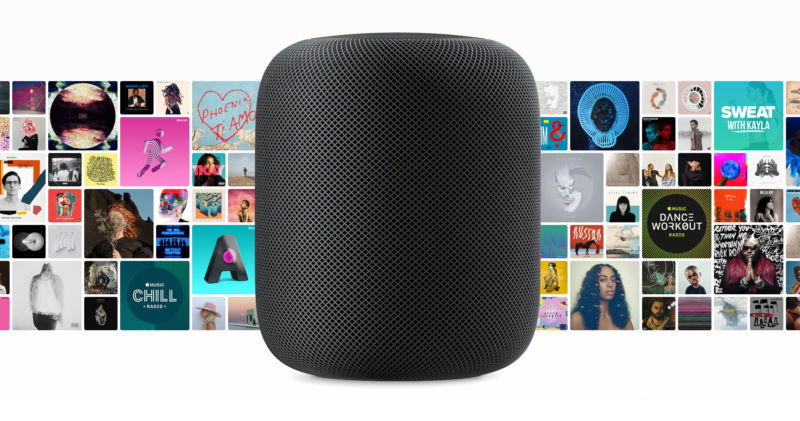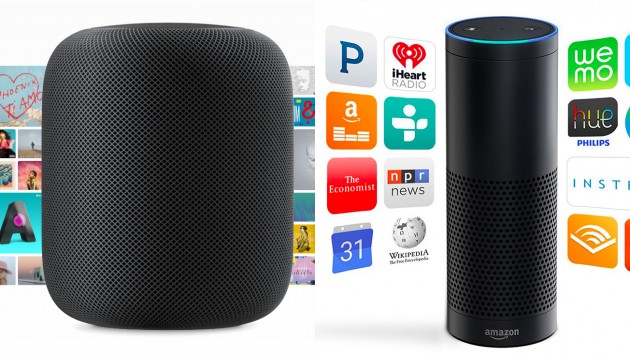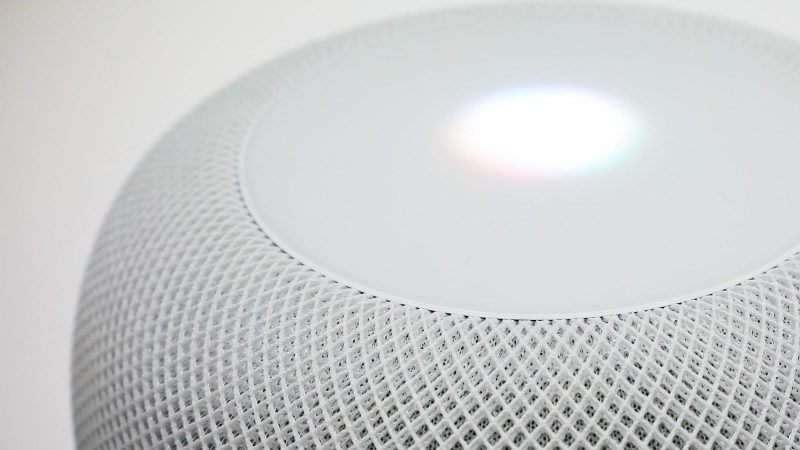
It seems Apple has taken a backseat latest with innovative tech gadgets, giving Microsoft, Google and even Amazon a leading edge into home AI. Amazon had a two-year head start, but now Apple is thundering into the marketplace with their HomePod.
One thing you know is that the Apple HomePod will be a huge upgrade over the Amazon Echo with a price to match it. Check out the Amazon Echo price points here.
Apple is hoping a new smart home speaker will strike a chord with music lovers – the latest test of the iPhone maker’s ability to redefine markets originally staked out by its rivals.
The trend-setting company also is putting new twists on existing products as it delves deeper into virtual reality and a form of artificial intelligence called machine learning.
The moves announced Monday escalate Apple’s technological battle of wits with Google, Amazon, Microsoft and Facebook. These giants are battling over still-emerging fields that are expected to turn into technological gold mines, much the way personal computers and smartphones became moneymaking machines in previous decades.
NO PLACE LIKE HOMEPOD
The “HomePod” speaker unveiled at Apple’s annual developer’s conference is similar to rival devices that have been released during the past two years.
Like the Amazon Echo and Google Home, the HomePod will play music while also helping people to manage their lives and homes. Siri, a digital assistant that has been on Apple’s iPhone since 2011, will be voice activated to respond to requests for information and other help around the house.
Unlike those other smart speakers, Apple is positioning the HomePod primarily as a way to listen to and discover new songs and artists. Making the most of it will require a subscription to Apple’s own music streaming service, which runs $10 to $15 per month and has attracted 27 million subscribers so far.
The company is casting Siri as a music connoisseur that will learn and cater to the tastes of the HomePod’s owners, as well as answer questions about the songs as they are played. “It will reinvent home audio,” boasted Apple CEO Tim Cook.
The speaker will sell for about $350 in December in the U.S., U.K. and Australia. Amazon sells the main version of the Echo for $180; Google’s Home speaker goes for $130.
The Echo, released in 2015, and Google Home, released last year, were the first entrants in a promising market. The research firm eMarketer says than 35 million people in the U.S. are expected to use a voice-activated speaker at least once a month this year, more than double its estimate from last year.
APPLE VS. THE DRY SPELL
The HomePod is Apple’s first new gadget in nearly three years, following its announcement of the Apple Watch in September 2014. Although that product came out after other smartwatches hit the market, it quickly outshone competitors, according to industry research firms.
Still, the Apple Watch hasn’t been a smash hit, fueling worries that the company’s ability to transfix customers had waned after the 2011 death of co-founder Steve Jobs. During Jobs’ last decade, Apple introduced the iPod, iPhone and iPad – all huge commercial successes that both reshaped daily life and swamped previous digital music players, smartphones and tablets.
Analysts said the smart home speaker market is ripe for Apple. The company “can’t afford to yield valuable real-estate in the heart of people’s homes to Amazon, Google and others,” said Geoff Blaber, research analyst at CCS Insight. That’s especially important because people are starting to access information, entertainment and search in a more “pervasive” way that’s less dependent on smartphones, he said.
But it’s also possible that the HomePod could expose Siri as less capable than Amazon’s Alexa, Google’s Assistant and Microsoft’s Cortana, Blaber said. (Many reviewers have suggested that the current incarnation of Apple’s assistant already trails competitors in key respects .) “This is the start of the AI wars,” he said.
MACS, PHONES AND PAYMENTS
Apple had plenty of other announcements. New iMacs released Monday are getting better displays and graphics capabilities. Apple said that makes the Mac a great platform for developing virtual-reality “experiences,” although the company didn’t announce any consumer VR products.
Safari, Apple’s web browser, is getting new features aimed at online annoyances. It will block videos that start playing automatically, for instance, and can also prevent ads from following and profiling users. It will not actually block ads, though.
Apple also introduced a new version of its business-oriented iPad Pro at an intermediate size with more storage, a better display, and an improved camera. It’s part of Apple’s effort to entice professionals with tablets that can handle many tasks previously reserved for laptops.
New features coming to iPhones and iPads, meanwhile, include marginal improvements such as syncing messages to Apple servers in the cloud, saving storage space on phones and tablets. Apple also laid some groundwork for augmented reality, the projection of digital features onto real-world surroundings, by giving app developers tools for incorporating AR into their products.
Apple is also bringing the ability to send money to friends or other people through its payment service, Apple Pay. So far, the service has limited payments to purchases of products and services from companies and other organizations.
The free software update for mobile devices, iOS 11, is expected in September, when Apple typically releases new iPhones.
So, just how does the Apple HomePod compare to the Amazon Echo?
APPLE HOMEPOD VS AMAZON ECHO – DESIGN
The Apple HomePod looks like a softer, smaller Mac Pro. That’s the first thing to enter my mind. It doesn’t scream for attention like some of Apple’s other designs, but that makes sense because this thing is supposed to blend into your surroundings. Apple says the material on the outside is a sort of acoustic mesh.
By contrast, the Amazon Echo looks a little more striking. Its sharp cylinder shape cuts a more imposing figure, and it’s taller too – it’s over 9 inches tall while the Apple HomePod is less than 7 inches.
At this stage, Apple hasn’t revealed many other physical aspects of the HomePod, so we don’t know about its connections. We know about it’s touch controls, but that’s about it. Hopefully, it will at least match the utility offered by the Amazon Echo, which has a volume dial, a mute button and a ‘wake up’ button for when you don’t want to shout the trigger word.
A 3.5mm input and Bluetooth connection would be great too – the Amazon Echo doesn’t have that, but the smaller Amazon Echo Dot does.
What we do know is that the Apple HomePod is packing some proper audio equipment, because it wants to be a viable music source. It has a 4-inch woofer and seven tweeters. Amazon’s woofer measures 2.5 inches. We can expect the Apple HomePod to shift a lot more air.
APPLE HOMEPOD VS AMAZON ECHO – FEATURES
The HomePod has an A8 processor inside, which is the same chip you’ll find inside one of the latest iPhones. What can that do? For starters, it’s smart enough to process spatial data and make acoustic adjustments for the best sound in any location. The Amazon Echo doesn’t have an equivalent function and puts out the same sound no matter where it is placed.
Apple HomePod is hooked up to Apple Music. That means it has your playlists as soon as you log in, and most importantly, it knows your music tastes. Amazon Echo doesn’t have that. It offers Amazon Music and Spotify, but neither of those can boast the ‘custom’ music service that is Apple Music’s unique selling point.
Spatial awareness and music tailoring aside that leaves the smart AI assistants. This is a much more even playing field, with Apple’s Siri versus Amazon’s Alexa. Both can complete basic tasks like setting timers or performing simple web searches for inane trivia. What else?
Siri is integrated with Apple HomeKit, and can control elements of your smart home that way. You can tell Siri / HomePod to turn off your lights or put the heating up. Amazon doesn’t have a hub system like HomeKit, but it does have a huge selection of third party ‘Skills’, and it has had a head start in home integration. You can use your voice to turn off Philips Hue lights as easily as commanding your Neato Botvac Connected robot to vacuum up in the kitchen.
Amazon Echo does have a big problem on the horizon, and it’s Apple’s big push to make Siri more intelligent and contextually aware. Siri will be able to take follow-up questions, like Google Assistant. It will also be able to translate. Currently, Alexa isn’t smart enough to do that.
APPLE HOMEPOD VS AMAZON ECHO – PRICE
This was always going to be a tough category for Apple to win since it generally makes expensive things. And the big number is… $349.
That’s a lot, but Apple hopes you’ll consider the HomePod as a proper audio device rather than just a smart speaker.
Amazon, meanwhile, is clearly the value proposition. The Amazon Echo costs $179, and the Amazon Echo Dot does plenty of the same things and costs just $49.



